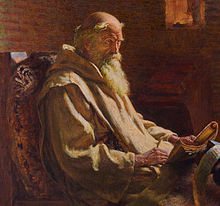Today is a rarity in our liturgical calendar, as we celebrate no less than three saints, each of them optional memorials: In order of time, we have first Saint Bede the Venerable (+735), an English monk, who was sent to the monastery of Wearmouth as a young boy of seven as a puer oblatus, and where he remained for the rest of his days, praying, reading, writing, working, chanting the Liturgy. Bede was considered the most learned man of his time, and one of the holiest, faithful to the end. At one point, as a teenager (he was about 14), the plague hit the monastery, and only the Abbot and young Bede were left to chant the hours, which they did faithfully, until some monks recovered, and others joined. Bede’s works cover almost the entire gamut of knowledge then known, and his Ecclesiastical History of England, ,a masterpiece of historical research, provides the foundation of current studies. Bede died peacefully, lying on the floor of his cell, surrounded by his beloved brethren, singing the Glory Be…
Saint Gregory VII, known also by his birth name of Hildebrand (+1085) was the Pope who instantiated the reform of the Church, the episcopacy and the priesthood that historically now goes by his name. In his struggles with Emperor Henry IV, Gregory helped shore up and clarify the primary spiritual authority of the papacy, and his personal example, prayers and witness solidified the Church herself as she emerged from so-called ‘dark ages’ into the glories of the early ‘middle ages’, much of which would not have been possible without Gregory, who shares much in common with the first Pope of that name, both of them helping save civilization from rack and ruin, as well as freedom from the ‘State’, whose totalitarian tendencies must always be resisted, primarily by spiritual means. Saint Gregory taught us that the Church is the path to heaven from earth, and Christ’s vicar (whatever his human limitations) the visible, hierarchical link between the two.
And finally, we have Mary Magdalene de’Pazzi (+1607), a Carmelite nun and mystic, offered great graces, ecstasies and visions by God in prayer from a young age, after a chaplain taught her to pray and meditate on the Passion of Christ. She made a vow of virginity at ten years old, and resisted attempts at marriage by her rich and noble family. Her father relented, and allowed her to enter the Carmelite monastery in Florence, which she chose since she could receive Communion daily. The description of some of her mortifications, if the contemporary accounts are not hyperbolic, are difficult to fathom, and are more to be admired than imitated, one might think. In the midst of all this, her visions continued, and her spiritual director asked that they be related to her fellow Sisters, eventually filling five volumes. Sister Mary Magdalene died on this day in 1607, and her body was found incorrupt six decades later. She was canonized in 1669.











